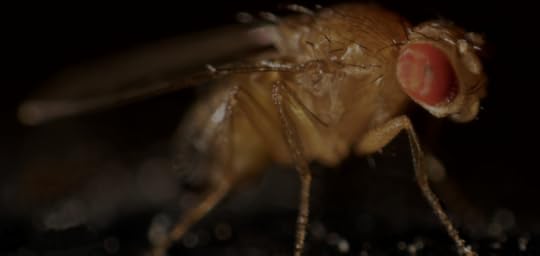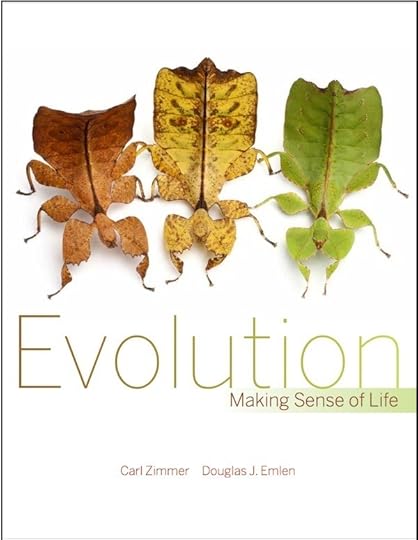Carl Zimmer's Blog, page 47
March 15, 2012
The Evolution of New York City: The Video
Last summer I wrote in the New York Times about the exploits of Jason Munshi-South, a biologist who studies evolution in the wilds of New York City. Jason has now given a nice quick talk for TED-ED, TED's new educational project, which is illuminated with lovely animations. Check it out:

March 14, 2012
Fifty-seven Years of Darkness
In caves around the world, animals and other creatures have adapted to endless night. Cavefish, for example, have lost their eyes and pigment, evolving a greater power in other senses.
In 1954, Syuichi Mori, a biologist at Kyoto University, put flies into a cave of their own. He took eggs from ordinary flies of the species Drosophila melanogaster put them in milk bottles, which he placed in pots and covered in dark cloth. There they lived in utter darkness. He tended to the flies, generation after generation, dividing them into three separate lines. Meanwhile, he reared three lines of flies in normal light for comparison.
Raising flies is not an easy business. They can pick up infections and die in droves. Over the years, all the normal lines of flies died out, as did two of the dark-bred flies. But Mori managed to keep the last line of flies alive in the dark, and after his death, other Kyoto researchers kept the flies going. And today, they are still living in the dark, 57 years since their ancestors last saw light. That's 1400 generations–which would be some 30,000 years if it ...
March 13, 2012
Bird Flu: Any Information to Declare?
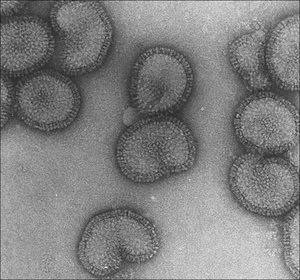 One thing that's fascinated me about the ongoing debate about the manipulated bird flu (check out my pieces for Slate, the Loom, and the Times for background) is that it comes down, in large part, to information. Should the scientists who turned bird flu into a mammal-to-mammal virus make the details of their experiments public?
One thing that's fascinated me about the ongoing debate about the manipulated bird flu (check out my pieces for Slate, the Loom, and the Times for background) is that it comes down, in large part, to information. Should the scientists who turned bird flu into a mammal-to-mammal virus make the details of their experiments public?
The debate has also touched on the concern that the viruses themselves might escape their labs. And yet the physical viruses have remained mostly in the background. If the information alone manages to get out, that might be enough for virologists to recreate the viruses. In fact, at a recent meeting about the flu in DC, a lot of the discussion about the security of these virus strains centered on the hard drives where the data is now stored.
The focus on information reflects how far synthetic biology, bioinformatics, and the Internet have all come in recent years. And there's now a new twist on this information debate, reported in a Dutch newspaper and followed up on by CIDRAP. One of the studies in question was conducted in the Netherlands. In a March 7 ...

March 10, 2012
Walking leaves: The cover of Evolution: Making Sense of Life
I'm delighted to be able to share the handsome cover of my next book. For the past couple years, I've joined forces with University of Montana biologist Douglas Emlen to write a textbook about evolution for biology majors. We built the book with some elements from my 2009 textbook for nonmajors, The Tangled Bank, along with much more math, additional concepts, detailed explorations of recent and classice studies on evolution, and study questions.
The book is slated to be published on August 15, 2012, in time for fall classes (here's the book page on the publisher's site). We're still ripping through the final proofs, but as soon as the cover was officially approved, I had to share it. The insects are walking leaves, which are not only beautiful, but a marvelous example of evolution at work.

March 9, 2012
Science, Journalism, and the Hype Cycle: My piece in tomorrow's Wall Street Journal
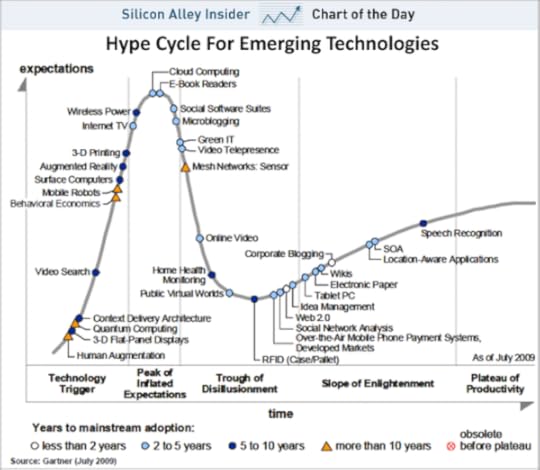 I think one of the biggest struggles a science writer faces is how to accurately describe the promise of new research. If we start promising that a preliminary experiment is going to lead to a cure for cancer, we are treating our readers cruelly–especially the readers who have cancer. On the other hand, scoffing at everything is not a sensible alternative, because sometimes preliminary experiments really do lead to great advances. In the 1950s, scientists discovered that bacteria can slice up virus DNA to avoid getting sick. That discovery led, some 30 years later, to biotechnology–to an industry that enabled, among other things, bacteria to produce human insulin.
I think one of the biggest struggles a science writer faces is how to accurately describe the promise of new research. If we start promising that a preliminary experiment is going to lead to a cure for cancer, we are treating our readers cruelly–especially the readers who have cancer. On the other hand, scoffing at everything is not a sensible alternative, because sometimes preliminary experiments really do lead to great advances. In the 1950s, scientists discovered that bacteria can slice up virus DNA to avoid getting sick. That discovery led, some 30 years later, to biotechnology–to an industry that enabled, among other things, bacteria to produce human insulin.
This challenge was very much on my mind as I recently read two books, which I review in tomorrow's Wall Street Journal. One is on gene therapy–a treatment that inspired wild expectations in the 1990s, then crashed, and now is coming back. The other is epigenetics, which seems to me to be in the early stages of the hype cycle. You can read the essay in full here.

March 8, 2012
The Great Brain Debate: New York, April 2

If you're in New York please consider joining me and Robert Krulwich of Radiolab on April 2 for a fascinating debate about the future of neuroscience. Tickets are free, but limited, so grab them when they become available on noon, 3/12.
Here are the details from the event page:
Does the brain's wiring make us who we are?
Two leading neuroscientists debate maps, minds and the future of their field.
Sebastian Seung (MIT)
vs.
Anthony Movshon (NYU)
Professor of Computational Neuroscience, MIT
Author of Connectome: How the Brain's Wiring
Makes Us Who We Are
Professor and Director,
Center for Neural Science, NYU
Moderators: Robert Krulwich of NPR's Radiolab and
Carl Zimmer, science journalist (NYTimes, Discover, NPR)
FREE AND OPEN TO THE GENERAL PUBLIC
What will be the next big breakthrough in neuroscience? What will finally explain how brains work, how they fail in disease, and what makes us each unique? Some neuroscientists believe that research would be radically accelerated by finding and deciphering "connectomes," maps of connections between neurons. Funding agencies are wagering millions of dollars on the idea that connectomics will be as fundamental to neuroscience as genomics is to molecular ...

This Week in Science: Jackalopes and our Inner Viruses
The video of my recent appearance on This Week in Science is on YouTube now. I turn up to talk about viruses at 42:50, as Kirsten Stanford and Justin Jackson splash freaky images of jackalopes, tree men, and other virus-related things. Check it out.

March 6, 2012
Autism and the blooming brain: My new column in Discover
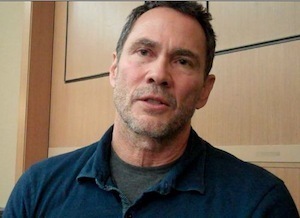
In my new column for Discover, I write about Eric Courchesne, a neuroscientist at the University of California at San Diego. Courchesne survived childhood polio, went on to become a champion gymnast, and then turned his attention to another nervous system disorder: autism. Courchesne is one of the first researchers to find anatomical differences in the brains of people with and without autism. He believes his findings point to autism's beginnings before birth, and perhaps even to new ways to treat it. Check it out.

Reminder: Science Ink in Guilford CT on Thursday
Just a quick reminder that I'll be talking about Science Ink on Thursday at 7 pm at the Guilford Free Library in Guilford, CT. I'll be in the lovely Historical Room on the second floor. Fortunately, I'll have some historical engravings of tattooed Maori and such to match the ambiance.

March 5, 2012
Making Influenza: my story in tomorrow's New York Times
 The ongoing controversy over experimental strains of bird flu is one of those multi-dimensional stories that you just can't fit into one article. I've written about it at Slate and here at the Loom, and I can point elsewhere to no end of excellent stuff. Fellow Discover blogger Ed Yong has a sharp, concise round-up on the research over at Nature, for example, and Michael Specter has a new story on it in this week's New Yorker (subscription required, alas).
The ongoing controversy over experimental strains of bird flu is one of those multi-dimensional stories that you just can't fit into one article. I've written about it at Slate and here at the Loom, and I can point elsewhere to no end of excellent stuff. Fellow Discover blogger Ed Yong has a sharp, concise round-up on the research over at Nature, for example, and Michael Specter has a new story on it in this week's New Yorker (subscription required, alas).
In tomorrow's New York Times, I take a look into one dimension of the story that has seemed under-explored to me. The controversy over the bird flu revolves around the risk that publishing the full details of the research could lead someone to recreate the virus and unleash a pandemic. Not just a terrorist or a hostile nation, but perhaps even a so-called "garage scientist" toiling at home. Is this a realistic risk, or unfounded fear? After talking to virologists who make viruses for a living and DIY biologists who don't, I find that the answer is pretty complicated. Check it out.




